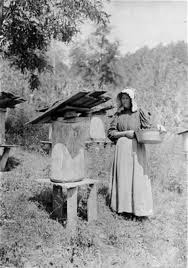Prior to the middle of the 19th century, most beehives were simple shelters for bees.
 |
| circa. 1830 - Scenes of Industry; Displayed in The Bee-Hive and the Ant-Hill |
Log gums were made from hollow logs then fitted with a roof. Sometimes a box or container was added on top of a log gum for the bees to store honey. Beekeepers inspected skep hives from the bottom.

Just as they do in the wild, bees attached their wax combs to the hive's roof and walls. Today we refer to these types of hives as fixed-comb hives. In these types of hives, the beekeeper could not inspect the hives. Therefore, it was difficult to know when the bees had a problem, rather from disease or when they became queenless.
In 1851, Lorenzo Langstroth created a new hive design with frames that hung from the top ends of the hive, leaving what we refer to as "bee-s[ace", a 3/8 inch space between all sides of the frames and hive body. This allowed the frames to be handled without breaking the comb.
By the year 1900, most beekeepers were using variants of this design, much like the ones used today.


Although the frames are similar in structure, please note, since I'm new to beekeeping, I have not developed the skills to handle bees without protective gear. So far no stings.😎 But I confess the suit is extremely warm. Maybe I'll appreciate it this winter?
Mail-order Bees
In the May 1879 issue of Gleanings in Bee Culture, A.I. Root proposed what would become a revolutionary idea - the sale of bees by the pound. Finding himself short on bees but with an abundance of honey just right for building up new colonies of bees,By counting and weighing a hundred bees, he came to the conclusion that a quart of bees would weigh approximately one pound and proposed to pay a dollar a pound for live bees delivered to him at the shipper's risk. He even went so far as to devise a cage in which they might be shipped.
New Release
Available on July 21st
Encouraged by his brother's success with his mail-order bride, Moses Montgomery is ready to take a chance. After all, he orders things from a catalog all the time, why not a wife? She should be sensible and take an interest in his business at the livery stable.
She's whimsical and fun-loving, he's gruff and likes to keep things simple. Has the matchmaking agency made an error in judgment? Can affection soften tow stubborn, opinionated individuals and help them find common ground?
About Kimberly Grist:
Kim has enjoyed writing since she was a young girl. However, she began writing her first novel in 2017, "I wear so many hats working inside and outside the home. I work hard, try harder, and then begin again the next day. Despite my best efforts, sometimes life just stinks. Bad things happen. I need and want an outlet, an opportunity to relax and escape to a place where obstacles are met and overcome."
Fans of historical romance set in the late 19th -century will enjoy stories combining, History, Humor, and Romance with an emphasis on Faith, Friends, and Good Clean Fun.
Connect with Kimberly:
Twitter: https://twitter.com/GristKimberly
Amazon Author Page: https://www.amazon.com/Kimberly-Grist/e/B07H2NTJ71












No comments:
Post a Comment